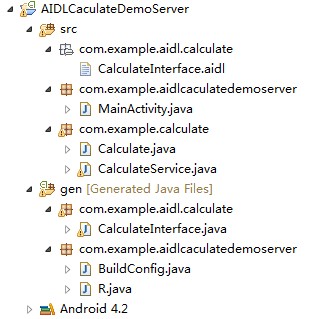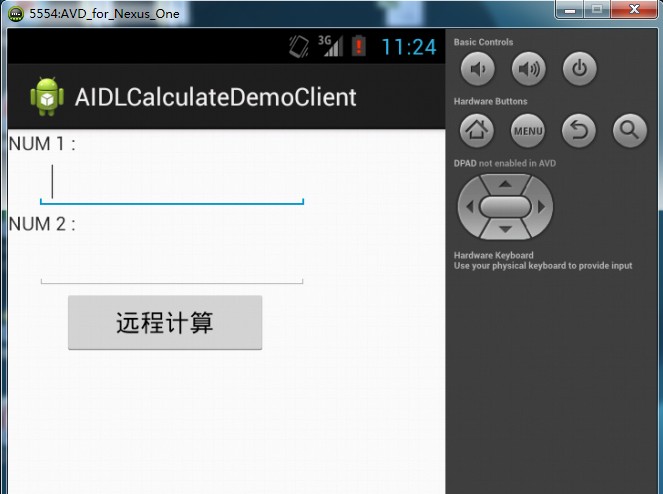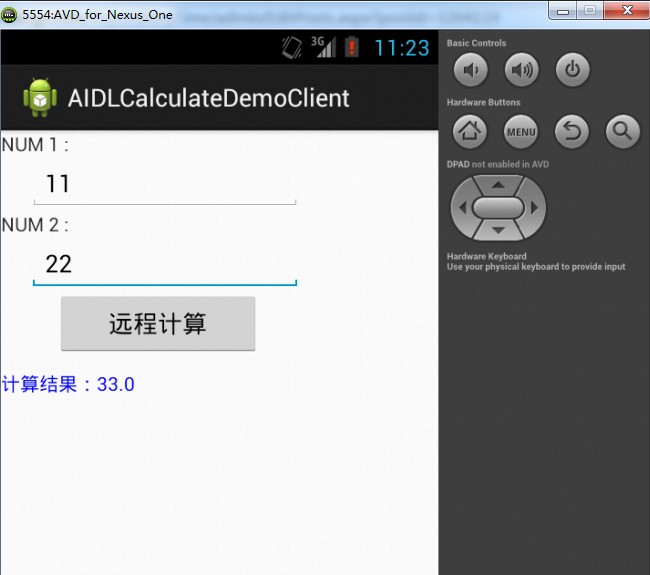一個android中AIDL的簡單例子
阿新 • • 發佈:2019-02-12
跨程序間的通訊:
關於IPC應該不用多介紹了,Android系統中的程序之間不能共享記憶體,那麼如果兩個不同的應用程式之間需要通訊怎麼辦呢?比如公司的一個專案要更新,產品的需求是依附於當前專案開發一個外掛,但是呢這個外掛功能以及介面比較複雜,不能和當前專案在一個程序中,同時呢,還要用到當前專案中已經寫好了的一些東西,那麼因為新開發的依附於當前專案的外掛和當前專案不是一個程序,因此不能共享記憶體,就出現了問題,於是,需要提供一些機制在不同程序之間進行資料通訊,這個機制就是AIDL了。
簡單的AIDL案例:
假如是這樣,現在有一個專案中提供了比較成熟的計算的方法,而現在我想開發一款軟體其中一個模組想用到一個計算類,而我又不想重新寫了,那麼就可以通過AIDL實現啦。假設,已經開發完成的那個已經提供了比較成熟的計算類的程式叫AIDLCalculateDemoServer(相當於伺服器),而我要寫的程式叫AIDLCalculateDemoClient(相當於客戶端),類似與客戶端伺服器模式。首先至關的看下工程結構圖:
圖1-1 伺服器

圖1-2 客戶端
現在假設自己寫的程式要呼叫服務端的運算介面,輸入num1和num2,進行遠端運算,呼叫服務端的介面,服務端運算好之後,返回結果給客戶端,效果圖如下:
然後來看看實現,首先需要定義AIDL介面,客戶端和伺服器端都要定義,並且要在同一包中,也就是圖1-1和圖1-2 com.example.aidl.calculate中的CalculateInterface,其中的程式碼如下:
CalculateInterface.aidl
package com.example.aidl.calculate; interface CalculateInterface { double doCalculate(double a, doubleb); }
編譯發現,目錄結構如圖1-1和圖1-2中gen/com.example.aidl.calculate中多了CalculateInterface.java檔案,內容如下:
package com.example.aidl.calculate;
interface CalculateInterface {
double doCalculate(double a, double b);
}定義好介面就是要看服務端和客戶端的程式碼啦,其中服務端主要看CalculateService程式碼,這個一個繼承Service的類,在其中對AIDL中的介面進行賦予實際意義,如下:
package com.example.calculate; import com.example.aidl.calculate.CalculateInterface; import com.example.aidl.calculate.CalculateInterface.Stub; import android.app.Service; import android.content.Intent; import android.os.IBinder; import android.os.RemoteException; import android.util.Log; public class CalculateService extends Service { private static final String TAG = "CalculateService"; @Override public IBinder onBind(Intent arg0) { // TODO Auto-generated method stub logE("onBind()"); return mBinder; } @Override public void onCreate() { // TODO Auto-generated method stub logE("onCreate()"); super.onCreate(); } @Override public void onStart(Intent intent, int startId) { // TODO Auto-generated method stub logE("onStart()"); super.onStart(intent, startId); } @Override public boolean onUnbind(Intent intent) { // TODO Auto-generated method stub logE("onUnbind()"); return super.onUnbind(intent); } @Override public void onDestroy() { // TODO Auto-generated method stub logE("onDestroy()"); super.onDestroy(); } private static void logE(String str) { Log.e(TAG, "--------" + str + "--------"); } private final CalculateInterface.Stub mBinder = new CalculateInterface.Stub() { @Override public double doCalculate(double a, double b) throws RemoteException { // TODO Auto-generated method stub Log.e("Calculate", "遠端計算中"); Calculate calculate = new Calculate(); double answer = calculate.calculateSum(a, b); return answer; } }; }
然後可以看看,關鍵的服務都提供完畢,那麼在客戶端是怎麼訪問的呢,要進行繫結服務和一個ServiceConnection類完成,如下:
package com.example.calculate;
import android.app.Activity;
import android.content.ComponentName;
import android.content.Context;
import android.content.Intent;
import android.content.ServiceConnection;
import android.graphics.Color;
import android.os.Bundle;
import android.os.IBinder;
import android.os.RemoteException;
import android.util.Log;
import android.view.View;
import android.widget.Button;
import android.widget.EditText;
import android.widget.TextView;
import com.example.aidl.calculate.CalculateInterface;
import com.example.aidlcalculatedemoclient.R;
public class CalculateClient extends Activity {
private static final String TAG = "CalculateClient";
private Button btnCalculate;
private EditText etNum1;
private EditText etNum2;
private TextView tvResult;
private CalculateInterface mService;
private ServiceConnection mServiceConnection = new ServiceConnection() {
@Override
public void onServiceDisconnected(ComponentName name) {
// TODO Auto-generated method stub
logE("disconnect service");
mService = null;
}
@Override
public void onServiceConnected(ComponentName name, IBinder service) {
// TODO Auto-generated method stub
logE("connect service");
mService = CalculateInterface.Stub.asInterface(service);
}
};
@Override
protected void onCreate(Bundle savedInstanceState) {
// TODO Auto-generated method stub
super.onCreate(savedInstanceState);
setContentView(R.layout.main);
Bundle args = new Bundle();
Intent intent = new Intent("com.example.calculate.CalculateService");
intent.putExtras(args);
bindService(intent, mServiceConnection, Context.BIND_AUTO_CREATE);
etNum1 = (EditText) findViewById(R.id.et_num_one);
etNum2 = (EditText) findViewById(R.id.et_num_two);
tvResult = (TextView) findViewById(R.id.tv_result);
btnCalculate = (Button) findViewById(R.id.btn_cal);
btnCalculate.setOnClickListener(new View.OnClickListener() {
@Override
public void onClick(View v) {
// TODO Auto-generated method stub
logE("開始遠端運算");
try {
double num1 = Double.parseDouble(etNum1.getText().toString());
double num2 = Double.parseDouble(etNum2.getText().toString());
String answer = "計算結果:" + mService.doCalculate(num1, num2);
tvResult.setTextColor(Color.BLUE);
tvResult.setText(answer);
} catch (RemoteException e) {
}
}
});
}
private void logE(String str) {
Log.e(TAG, "--------" + str + "--------");
}
}如此一來,大功已經基本告成,最後,我們在來看看服務端的配置檔案吧:
<?xml version="1.0" encoding="utf-8"?>
<manifest xmlns:android="http://schemas.android.com/apk/res/android"
package="com.example.aidlcaculatedemoserver"
android:versionCode="1"
android:versionName="1.0" >
<uses-sdk
android:minSdkVersion="8"
android:targetSdkVersion="17" />
<application
android:allowBackup="true"
android:icon="@drawable/ic_launcher"
android:label="@string/app_name"
android:theme="@style/AppTheme" >
<activity
android:name="com.example.aidlcaculatedemoserver.MainActivity"
android:label="@string/app_name" >
<intent-filter>
<action android:name="android.intent.action.MAIN" />
<category android:name="android.intent.category.LAUNCHER" />
</intent-filter>
</activity>
<service android:name="com.example.calculate.CalculateService">
<intent-filter>
<action android:name="com.example.calculate.CalculateService" />
</intent-filter>
</service>
</application>
</manifest>二、寫AIDL注意事項
1. 客戶端和服務端的AIDL介面檔案所在的包必須相同
2. 需要一個Service類的配合
相關文章:



